Laser head patterns
I was back in Austin for Thanksgiving last week. While hanging out in the room where my dad tutors his students, undoubtedly chatting with him about what on earth I’ll do next year, I started playing with his laser pointers. He has two, one of which has multiple heads that you can screw on to get different pointer shapes (like this one). There are heads for an arrow, a circle, a line, and a cross, in addition to the normal pointer. The heads look like basically like a piece of glass in a metal frame, and I wondered: What are the patterns on the glass that produce these different pointer shapes?
Miraculously, I also happened to notice that my dad now has a little microscope! So I plunked the laser pointer heads underneath it, to try to see what they look like.
And I can’t say that I understood what I saw. For the line-shaped pointer, I saw lots of lines etched in the glass, seemingly in parallel:
But with the arrow-shaped pointer head, I saw something very weird:
…No little arrows all over, but rather, a pixelated etching of wavy lines! All I can imagine is that this is something like one of those Magic Eye pictures where an image appears when everything lines up just right.
Does anyone know how this works?
Mapping your world
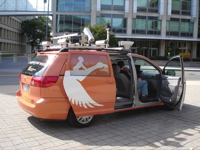 Tele Atlas held a workshop at the Media Lab today, and I got to go on a ride in one of their “mobile mapping vans”. They drive up and down the streets of major cities and highways in this van, which is equipped with several cameras and laser range-finders on the roof, with a GPS receiver and a rack of memory on the inside. Tele Atlas uses the imagery and distance data to help enhance and texture their new 3D maps, which nicely represent the shapes and appearance of the buildings along the streets.
Tele Atlas held a workshop at the Media Lab today, and I got to go on a ride in one of their “mobile mapping vans”. They drive up and down the streets of major cities and highways in this van, which is equipped with several cameras and laser range-finders on the roof, with a GPS receiver and a rack of memory on the inside. Tele Atlas uses the imagery and distance data to help enhance and texture their new 3D maps, which nicely represent the shapes and appearance of the buildings along the streets.
I climbed in next to the rack, in the only back seat, while my two friendly mapper-driver-dudes took me on a 5-minute ride around MIT, so that I could see the cameras in action. They have cameras on the roof, pointing to either side of the van, and two angled up at about 45º to get snapshots of taller buildings. They also have a “spherical” camera called a Ladybug, which has five cameras arranged in a ring, in a red housing. On either side of the roof are laser range-finders that map out the building layouts and shape as viewed from the road. (I love that the laser manufacturer is named SICK, and that they display this proudly on their devices.)
The guy in the passenger seat looks at maps and camera feeds on a pole-mounted laptop next to the seat, adjusting apertures and directing the driver to roads they have not yet covered. He’ll also mark a road if it’s under construction or one-way.
It seems slow-going; the van can’t take measurements if it travels above 33 mph. This guy’s been working with his partner to map Boston and Cambridge since the beginning of August. They’ll finish in the next week or two, and then move on to another city. I asked him how long it takes to map an area, and he tells me, “It depends on the traffic… Yesterday it was really bad in the Back Bay and Brookline, so we only covered about 75 kilometers in 6 hours.” On a good day, his best, they covered 170 km (106 mi).
Let the geo-nerditry commence!
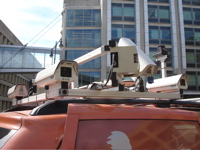
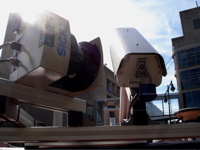
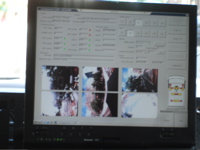
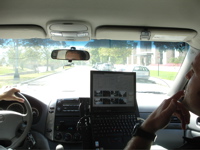
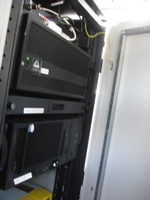
Why you shouldn’t put hydrocortisone on your face for too long
[I’m going to purge some old post drafts over the next couple of days.]
At the beginning of the summer, I had a spat of illness, including the flu, persistent coughing, and a rash.
Let’s talk about the rash, since such things are always so topical. I had pink skin peppered with red bumps on the lower left side of my face, and it was super itchy. So I decided to put some hydrocortisone on it, right?
Apparently not. My tube of cream says “Do not use on the face except if advised by a doctor”, which seemed a little mysterious to me. But here’s why:
- Hydrocortisone can thin the skin and brings capillaries to the surface (if prescription-strength and/or used for more than a few days at a time). On your leg, capillaries under thin skin isn’t so bad, but on your face, it can be unsightly. ((Explanation, and “Prominent capillaries” picture near bottom of http://dermnetnz.org/treatments/topical-steroids.html))
- Steroids are absorbed much more easily on the face, and higher absorption can cause adrenal gland suppression or Cushing’s syndrome. ((http://dermnetnz.org/treatments/topical-steroids.html))
From National electronic Library for Medicines ((Word DOC from NeLM)):
When topical hydrocortisone was approved for over-the-counter sale, the use of a steroid on delicate facial skin was not considered an appropriate indication. Long-term and/or high strength steroids can damage the skin (1,2), and on the face this would be particularly noticeable. These problems have not been demonstrated with short-term OTC hydrocortisone, but form a theoretical basis for caution. In addition to this, some common skin conditions affecting the face can be caused or made worse by hydrocortisone (eg impetigo, rosacea, and acne) (1,2). Therefore all over-the-counter hydrocortisone creams and ointments have “use on the face” as a contra-indication, and pharmacists are not allowed to sell them for this purpose.
Patients with skin conditions affecting the face ought to see their GP first, rather than self-medicating. GPs can prescribe hydrocortisone for use on the face, having first assessed the appropriateness of doing so.
My doctor ended up telling me I could use the over-the-counter stuff on my face, if I only needed it for a few days. (“It’s the prescription stuff you really have to worry about.”)
Asparagus pee
Sadly, I don’t have time to write much today. But I *did* eat asparagus with dinner, and my pee smells obnoxious. I poked around online to see why, and here’s my favorite answer (even so, not so satisfying an answer):
The Straight Dope: Why does asparagus make your pee smell funny?
…Benjamin Franklin, in a wide-ranging discussion of bodily discharges, once noted, “a few stems of asparagus eaten shall give our urine a disagreeable odor; and a pill of turpentine no bigger than a pea shall bestow upon it the pleasing smell of violets.”
It is said that in a venerable British men’s club there is a sign reading “DURING THE ASPARAGUS SEASON MEMBERS ARE REQUESTED NOT TO RELIEVE THEMSELVES IN THE HATSTAND.”
(…And I’m still wondering how it can start smelling so bad so quickly! Today must have been 10-15 minutes.)
Why we get goose bumps
 I thought goose bumps were my skin’s attempt to get tighter, to cinch in and keep me warm. But that’s not quite right. Getting goose bumps is something the body does to keep warm, but what it’s doing and why is funny. And useless.
I thought goose bumps were my skin’s attempt to get tighter, to cinch in and keep me warm. But that’s not quite right. Getting goose bumps is something the body does to keep warm, but what it’s doing and why is funny. And useless.
When we’re cold, our body makes our hairs stand on end, to create an insulating layer on the skin. Just like a good down coat… what a great idea. The only problem with this is that we have so little hair that this doesn’t actually warm us up; it’s just a vestigial reaction from our salad days when we were much hairier. Since the hairs standing upright make our skin pucker, the end result is just general, unflattering-yet-cute bumpiness.
We have little muscles called erectores pilorum [*snicker*] that contract to pull our hairs up like that. It’s the same mechanism that makes a cat’s hair stand on end, and raises a porcupine’s quills when threatened.
The Wikipedia entry on goose bumps currently says: “[goose bumps] are the bumps …which involuntarily develop when a person is cold or experiences strong emotions such as fear, awe, or the need to defecate.” Hahahaha, don’t you just love that… strong emotion of the need to defecate…
I got on this subject because Ian asked me a little while ago how it is that we stay warm… specifically, what part of the body does that? And I don’t know the answer to this question.
If anyone reading knows the answers to any of these questions, please share!
- Where does the heat in our bodies come from?
- How does the body “know” whether it’s too hot or too cold? What part of the body determines this?
- What determines the optimal temperature for an animal? Why is ours somewhere in the range of the high 90s Fahrenheit?
My tingly face
I think I figured out why my face used to tingle when I swam.
When I started swimming laps regularly a few months ago, my face always tingled all over and was slightly numb when I got out of the pool. I guess I hadn’t noticed that I ever stopped feeling tingly after swimming, because today, after my mile swim with Brent, I noticed it again for the first time in a long while.
The other thing that struck me while swimming today is that I was having great trouble getting as much air as I wanted into my lungs. I think I’ve become much more aware of breathing since I started swimming, and today I knew it didn’t feel right. I suppose there are many reasons I could’ve had trouble breathing today: I haven’t exercised much in the last two weeks, I haven’t slept much, and I recently had a spike in pizza intake… all possibilities.
Regardless of the reason for my trouble breathing today, I’m fairly convinced that the correlation of trouble breathing and tingly face means that the tingling comes from a lack of sufficient oxygen for an extended period.
Lightning and thunder (and tweeks, sferics, and whistlers)
 The sound that comes from lightning sounds the way it does – a crack followed by a rumble – because the high frequency sounds from the explosion travel more quickly through the atmosphere than the lower frequency sounds. This is called “dispersion” ((http://www.physics.uoguelph.ca/summer/scor/articles/scor163.htm — best link if you’re just going to read one of these)). It’s the same phenomenon that you see in optics when light gets split through a prism.
The sound that comes from lightning sounds the way it does – a crack followed by a rumble – because the high frequency sounds from the explosion travel more quickly through the atmosphere than the lower frequency sounds. This is called “dispersion” ((http://www.physics.uoguelph.ca/summer/scor/articles/scor163.htm — best link if you’re just going to read one of these)). It’s the same phenomenon that you see in optics when light gets split through a prism.
The farther you are from the lightning, the more low frequency sound you will hear in the thunder ((http://www.madsci.org/posts/archives/nov99/943317470.Ph.r.html)). This is due to both dispersion, which attenuates the high frequencies more ((http://www.physics.uoguelph.ca/summer/scor/articles/scor163.htm)), and diffraction, which helps low frequency sounds “bend around” obstacles better than high frequency sounds ((http://hyperphysics.phy-astr.gsu.edu/hbase/sound/diffrac.html)), so they can travel farther.
Radio waves are affected by dispersion as well. While reading about lightning and thunder, I stumbled across this amazing thing: very low frequency (VLF) radio receivers for the Earth’s natural radio emissions. The sound samples on this page are really cool.
This is crazy stuff. You can listen to a live VLF audio stream through the NASA online VLF receiver.
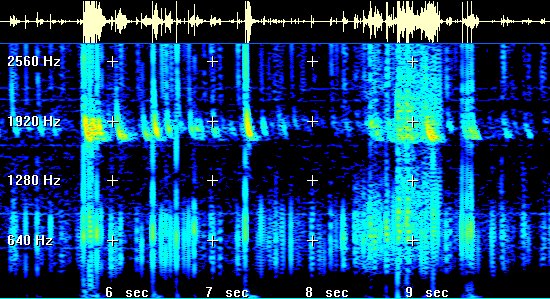
What is a nor’easter
 Apparently I missed another “nor’easter” last weekend while I was off in sunny, life-warming California. I thought a nor’easter was just a storm in the northeastern US. The trusty Wikipedia tells me not only what a nor’easter is, but also has a whole page devoted to the storm Boston just had.
Apparently I missed another “nor’easter” last weekend while I was off in sunny, life-warming California. I thought a nor’easter was just a storm in the northeastern US. The trusty Wikipedia tells me not only what a nor’easter is, but also has a whole page devoted to the storm Boston just had.
A nor’easter … is a macro-scale storm whose winds come from the northeast, especially in the coastal areas of the Northeastern United States and Atlantic Canada. More specifically, it describes a low pressure area whose center of rotation is just off the coast and whose leading winds in the left forward quadrant rotate onto land from the northeast. The precipitation pattern is similar to other extratropical storms. They also can cause coastal flooding, coastal erosion and gale force winds.
I missed the last listed nor’easter (November 2006) while I was in St. Louis. And last month, while I was in Seattle, I missed another storm. Is coincidence??
How to keep bananas ripe
I eat a banana every day, and I am always trying to optimize the combination of ripeness of the bananas that I buy. I often buy a couple of totally yellow ones, along with a few green ones for after I’ve eaten the yellow ones. But I totally misjudge them sometimes and end up eating a brown mush, or a hard, almost bitter thing that I can hardly get the skin off of.
Below, I’ve copied some snippets of info I found on ripening fruits. A lot of people know this stuff already, but I didn’t think to keep bananas in the fridge, and I can never remember which fruits continue ripening (i.e., which ones you can still have hope for) and which ones are WYSIWYG.
From Why do some fruit ripen only on the tree and others ripen only after they are picked?:
Bananas when harvested mature have very high levels of starch (like a potato). During ripening this starch is converted to soluble sugars and that is why they taste sweeter when they are ripe. The hormone ethylene is normally used to trigger ripening in bananas (and also avocados) by applying ethylene gas into a ripening room for a period of time. The application of ethylene gas helps to reduce fruit to fruit variability in ripening time as well shortening the overall ripening time.
The avocado and banana are classified as climacteric fruits whereas the pineapple is classified as a nonclimacteric fruit. Nonclimacteric fruit do not exhibit the increase in respiration nor the rise in ethylene production nor do they normally undergo dramatic changes (such as softening) after harvest.
(from Howstuffworks “Health Benefits of Fruits…”)
Fruits that will continue to ripen [climacteric]:
- Apricots
- Avocados
- Bananas
- Cantaloupe
- Kiwi
- Nectarines
- Peaches
- Pears
- Plums
- Tomatoes
Fruits to buy ripe and ready to eat [nonclimacteric]:
- Apples
- Cherries
- Grapefruit
- Grapes
- Lemons
- Limes
- Oranges
- Pineapple
- Strawberries
- Tangerines
- Watermelon
From “Fruit Ripening”:
How can you assist fruit ripening? First let me tell you that bananas are shipped to the US as hard, green, sour, unripened fruits. They ship better that way. They arrive into a distributor’s warehouse without bruises. The bananas are put in a room and gassed with ethylene. They all begin to ripen. You buy them at the store and within a few days the ripening process is so rapid that the bananas are “over the hill” before you can eat them all.
By the way, you can allow the bananas to ripen to the stage you like them and then put them in the refrigerator. This slows the ripening process down drastically. For several days after that you can take bananas from the refrigerator and enjoy the fruit inside. Please note: the skin will turn very dark in color after only a short time in the refrigerator…you can ignore that…the fruit inside remains just as it was before you put the banana into the refrigerator.
The ripening bananas produce so much ethylene that you can use them as a tool to ripen other fruits. Take those green pears home and put them on the shelf in a paper bag with a banana. The banana at room temperature produces ethylene that will signal the green pears to start ripening immediately. The paper bag holds the ethylene in stagnant air around the fruits, yet allows oxygen to go into the bag for respiration in the fruits…needed to make the enzymes! In just a few days the pears should be ready to eat! You can do the same with avocados.
Escalators
Brent may not remember this, but we once wondered how many stories the escalator at the Porter Square T station, Boston’s deepest subway station, covers. It’s a really long escalator – one of the longest I’ve ridden.
 The Wikipedia entry on the Porter station and this article on a scary escalator accident that occurred there both claim that the long escalator out of Porter station is 143 feet long.
The Wikipedia entry on the Porter station and this article on a scary escalator accident that occurred there both claim that the long escalator out of Porter station is 143 feet long.
I did a few calculations using numbers from the Wikipedia entry on escalators (a surprisingly and wonderfully interesting read), and found that a typical angle of incline for an elevator might be around 27º. This means that the Porter escalator covers about 65 feet in vertical distance, which, depending on how tall you think a “story” is, is somewhere between four stories and 5.5 stories.
(Incidentally, the Porter Square T station has a really cool art piece spread throughout, worth looking out for if you find yourself there.)
Some highlights from the Wikipedia entry on escalators:
- “passengers who stand customarily stay on one particular side of the escalator, leaving the other side free for walkers. The proper side for walking does not necessarily correspond with the passing lane in road traffic: passengers stand on the right and walk on the left on the London Underground as well as the Washington, Boston, Hong Kong, Toronto, and Moscow subway systems; but in Singapore and Australia, they stand on the left. In Japan, riders stand on the left in Tokyo but on the right in Osaka.”
- “For fun, people sometimes use an escalator running in the opposite direction, climbing up or down the stairs faster than it moves. This is forbidden in some places, notably the Paris Métro, where running in the opposite direction can lead to being fined.”
Here’s a picture Hansie took last December, of me looking at escalator innards at the Harvard Square T stop:






